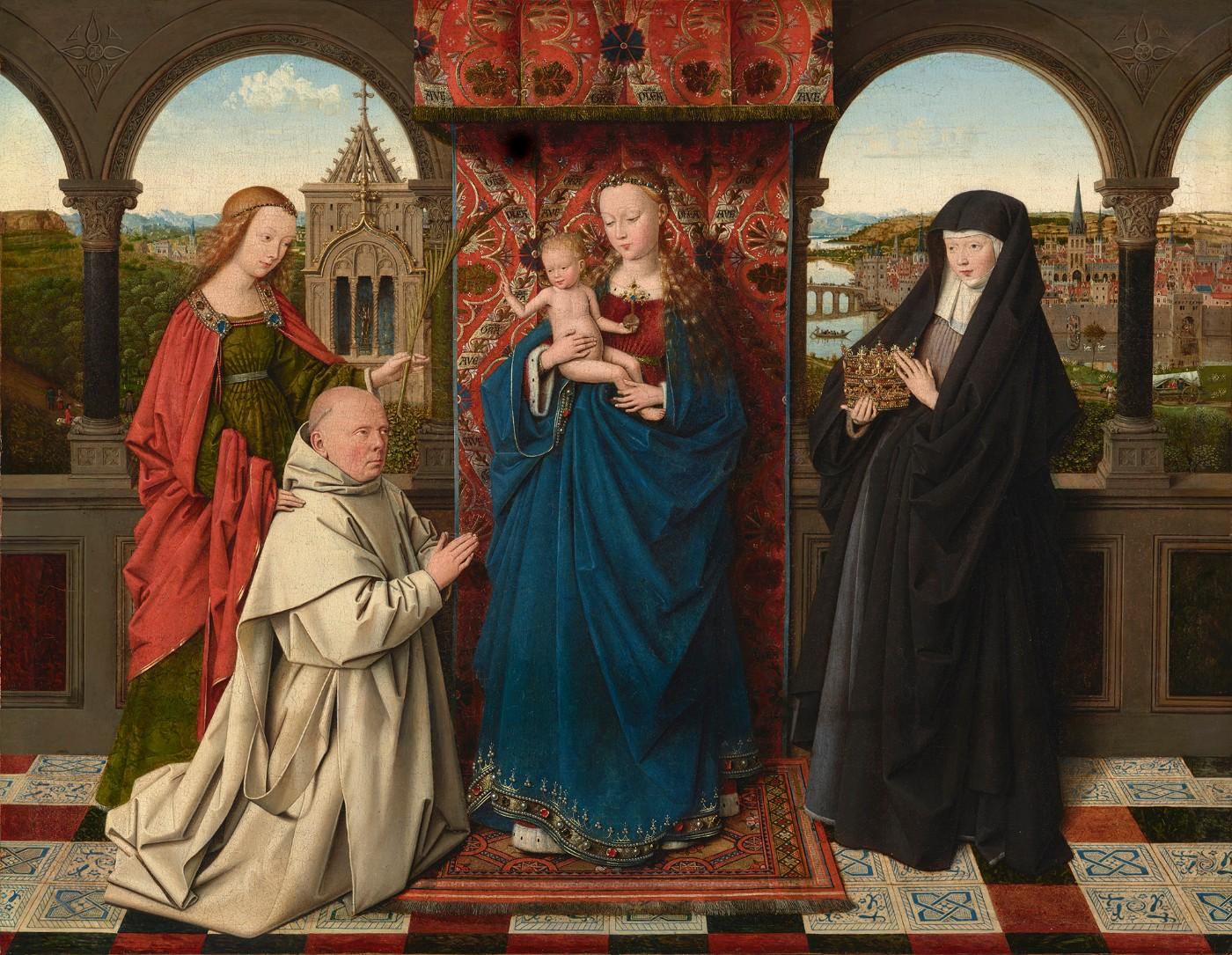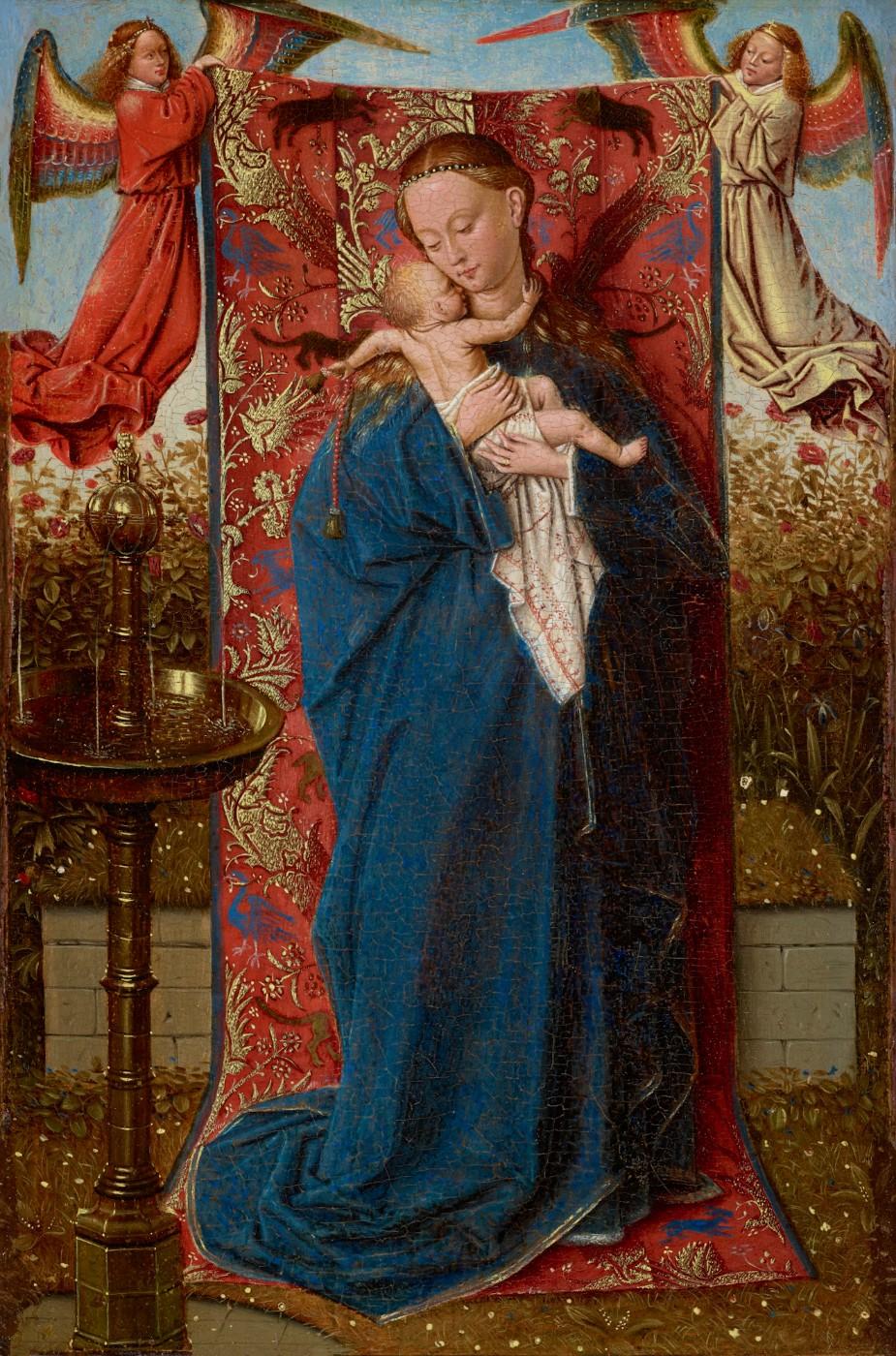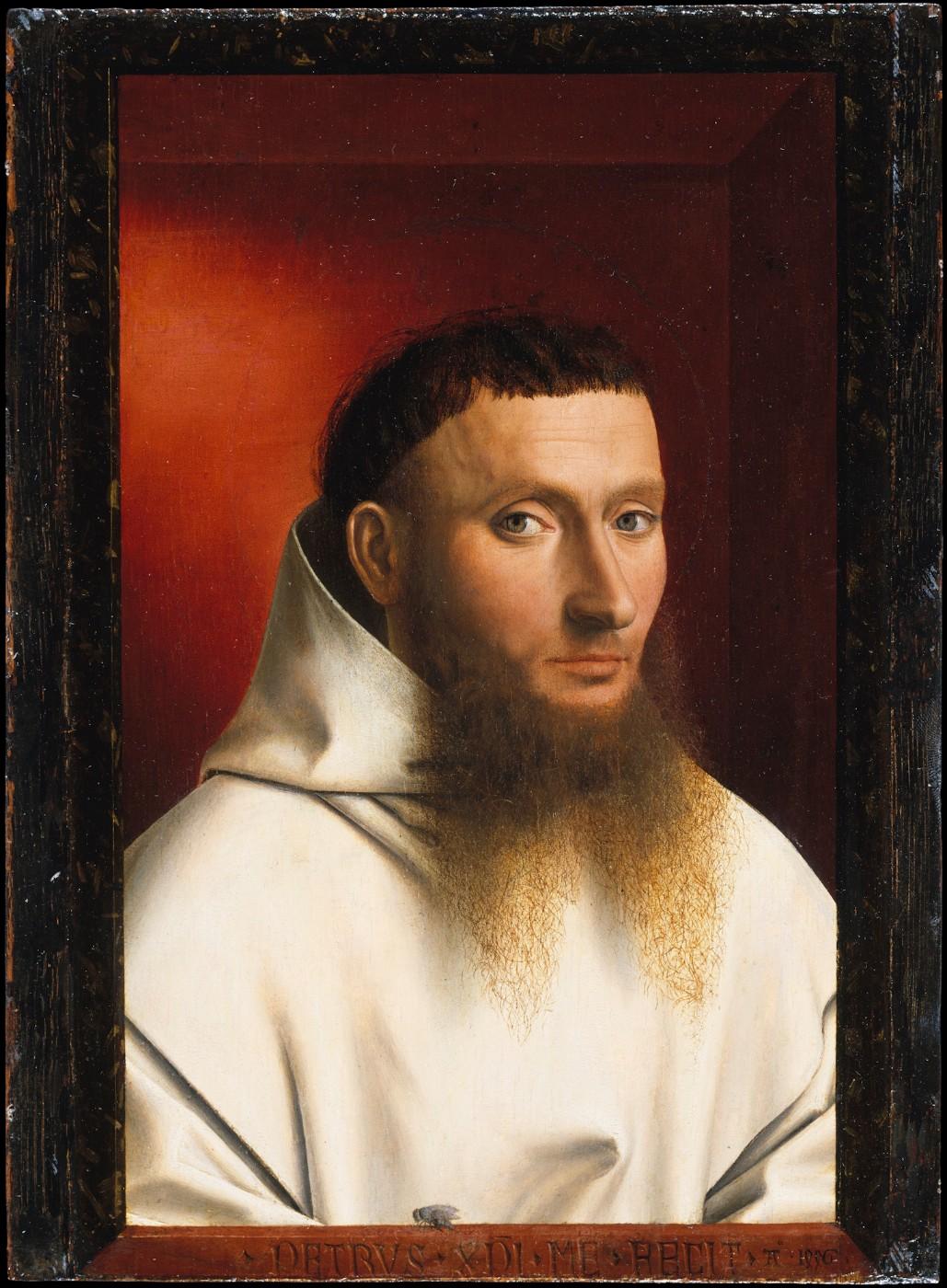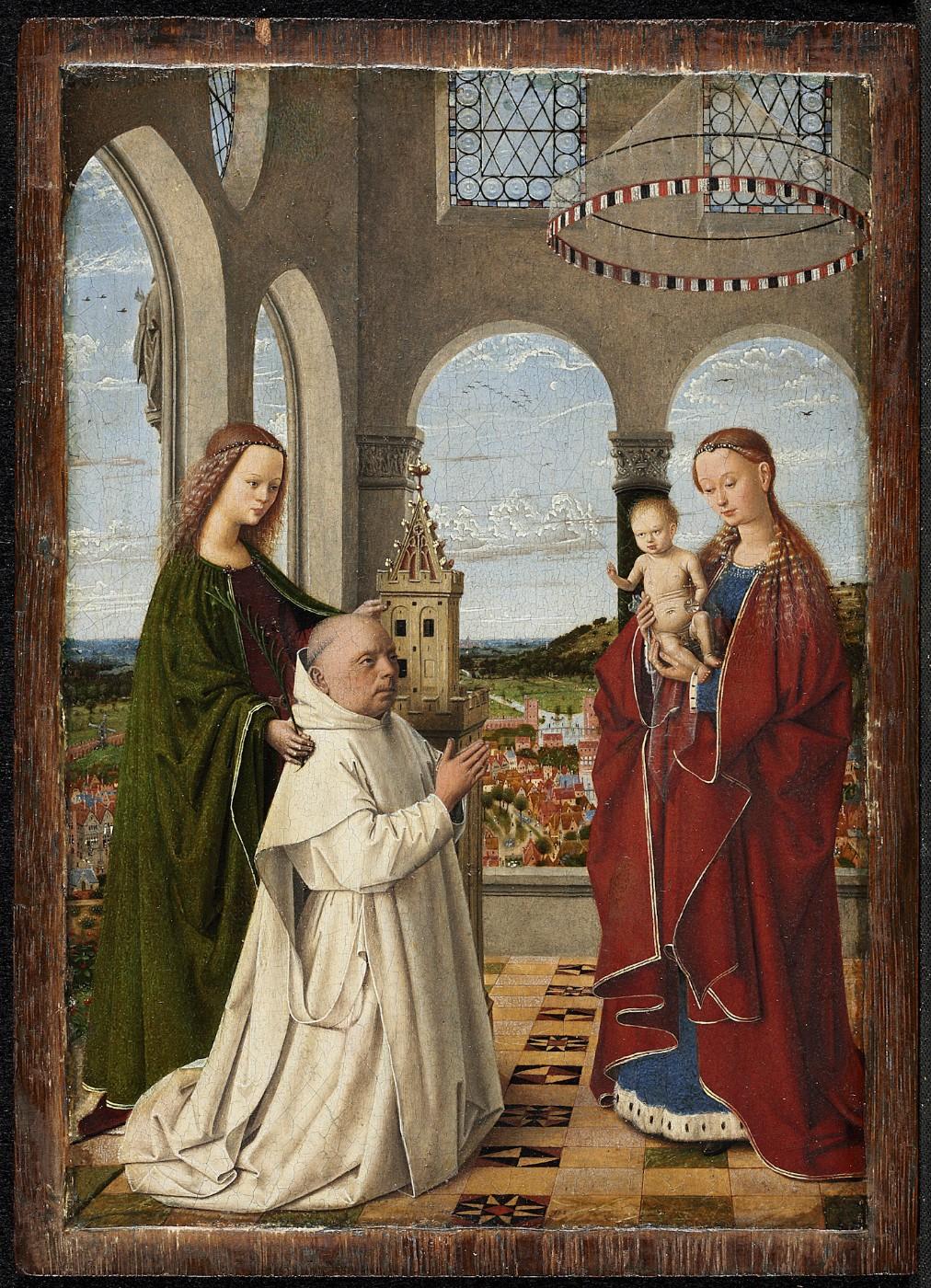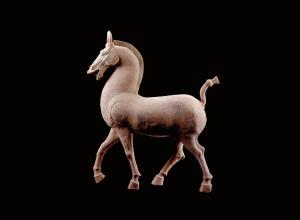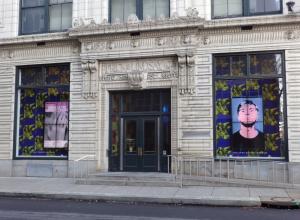Because of its diminutive size (7 5/8 x 5 1/2 in.), it is probable that the Exeter Virgin served a devotional purpose. As the fourteenth-century Carthusian writer Guillaume d’Ivrée recounted, such images were frequently found in monks’ cells, where they were meant to “excite devotion and imagination, and augment devotional ideas.” This is consistent with meditative practices of the period, which relied on physical images to help conjure mental ones. Images provided the crucial first step for this spiritual progress: they helped focus the monks’ minds and allowed them to visualize themselves in the presence of holy beings. Looking at his own likeness in the company of the Virgin, Christ, and Saint Barbara would have helped Vos visualize this divine encounter in his mind’s eye. This reliance on mental images and visualization is not so different from exercises promoted by mindfulness meditation today. Images were all the more important for an order whose members spent the majority of their time in their cells, in solitary prayer: images, especially ones as rich in detail as the Frick and Exeter Virgins, would have offered endless possibilities for examination, helping to relieve the mental strain of complete isolation.
The function of the Frick Virgin is more difficult to ascertain. Previous studies have identified it as either a devotional work or an altarpiece. A recent examination of the archives of the Utrecht charterhouse—where Vos took the panel after leaving Bruges in 1450—provides compelling evidence that it had served as his memorial, a type of funerary monument popular in northern Europe during the late fourteenth and fifteenth centuries. Broadly defined, memorials (also called votive tablets or epitaphs) were large painted or sculpted tablets, which depicted a deceased donor being introduced by saints to holy figures—in most cases the Virgin and Child—whose intercession they sought. Generally, memorials would be placed above the tomb of the deceased, thus functioning as grave markers. Their frames usually bore an inscription that identified the deceased and petitioned passers-by to pray for the repose of the deceased’s soul. Indeed, during the fifteenth century, prayers from the living were believed to hasten the release of the deceased’s soul from purgatory into heaven, and memorials were created specifically in order to secure suffrages for the dead.
This was not the first time that Van Eyck was commissioned to paint a memorial: his monumental Virgin and Child with the Canon Joris van der Paele (ca. 1434–36) originally hung in Bruges’ Church of Saint-Donatian, above Van der Paele’s grave. (It is now in the Groeningemuseum in Bruges.) Another memorial by the artist, The Virgin and Child with Nicolas van Maelbeke, was completed probably around the time Vos arrived in Bruges. Although lost, the panel is known through two silverpoint drawings from about 1445 (now in the Germanisches Nationalmuseum in Nuremberg and the Albertina, Vienna). The latter, attributed to Petrus Christus, is featured in the exhibition. This composition inspired the Exeter Virgin and shows the impact of Van Eyck’s legacy on the younger painter.
When Vos began his tenure as prior of Genadedal, he was probably in his fifties, at an age when one usually started planning for death. By then Van Eyck had completed his memorials for Van der Paele and Van Maelbeke, which may have been known by Vos, perhaps prompting him to commission the artist to produce a similar (though more modest) in size memorial for himself.
In 1443, about two years after the completion of the Frick Virgin, Vos petitioned his acquaintance, Bishop Martin de Blija, to attach to the memorial an indulgence—that is, a grant that promised passers-by a remission of time served in purgatory in exchange for their prayers. Specifically, the indulgence guaranteed forty days of pardon to whoever would greet the Virgin in the Frick panel with the Ave Maria, the first line of which, significantly, appears embroidered on the canopy behind the Virgin, suggesting that Vos planned from the onset of the commission to seek an indulgence for the panel. The painting’s imagery thus invited viewers to recite the indulgenced prayer. The indulgence could also be gained by saluting the panel’s images of Saint Barbara or Saint Elizabeth by reciting both the Ave Maria and the Pater Noster. Forty-day indulgences were by no means uncommon during the late Middle Ages, and they were frequently granted to encourage prayers in front of newly made images. As a spiritual privilege granted to the Carthusians, the indulgence was only valid as long as the image remained within the order. Thus, on the walls of The Frick Collection, the Virgin has lost its supposed power of spiritual remission.
What prompted Vos to seek an indulgence for his memorial? Effectively, the indulgence made the painting’s beholder a mutually beneficial offer: in addition to benefitting Vos’s soul, the recitation of special prayers in front of the panel would also improve the viewer’s prospects for salvation through the remission offered by the indulgence. Vos thus used the indulgence to call attention to his memorial and incentivize suffrages for his soul among his fellow monks. In procuring the indulgence, Vos transformed the panel into a currency in the economy of salvation that pervaded the era.
The Frick and Exeter Virgins survived the destruction of the Bruges and Utrecht charterhouses during the religious wars, in 1578 and 1580 respectively. While Vos’s body lies anonymously somewhere beneath the residential buildings that now stand on the site of the Utrecht charterhouse where he died in 1462, his memorial hangs on the walls of The Frick Collection. Venerated today for its artistic qualities rather than as an object that helped one secure salvation, Vos’s memorial has fulfilled its function, though perhaps not in the way that he had anticipated: it has kept alive the memory of this Carthusian monk, whose patronage of Van Eyck and Petrus Christus gave us two masterworks of early Netherlandish painting.
Publication
The exhibition is accompanied by a beautifully illustrated catalogue written by curator Emma Capron with essays by Maryan Ainsworth, Curator of European Paintings at the Metropolitan Museum of Art, and Till-Holger Borchert, Director of the Bruges Museums. It is published in association with D Giles Limited. Drawing on recent technical examination information and new archival research on the works commissioned by Jan Vos, the volume explores the panels’ creation, patronage, and function in their rich Carthusian context. The book (hardcover, 160 pages, 85 color illustrations; $44.95) is available in the Museum Shop or can be ordered through the Frick’s Web site (www.frick.org) and by phone at 212.547.6848.
Major funding for the exhibition is provided by Howard S. Marks and Nancy Marks and an anonymous gift in memory of Melvin R. Seiden. Additional support is generously provided by The Andrew W. Mellon Foundation, the General Delegation of the Government of Flanders to the USA, Mr. and Mrs. Michael J. Horvitz, Margot and Jerry Bogert, Harlan M. Stone, an anonymous donor, the Samuel H. Kress Foundation, and Nicholas Hall. The accompanying catalogue is underwritten, in part, by the Flemish Research Centre for the Arts in the Burgundian Netherlands, Musea Brugge.




